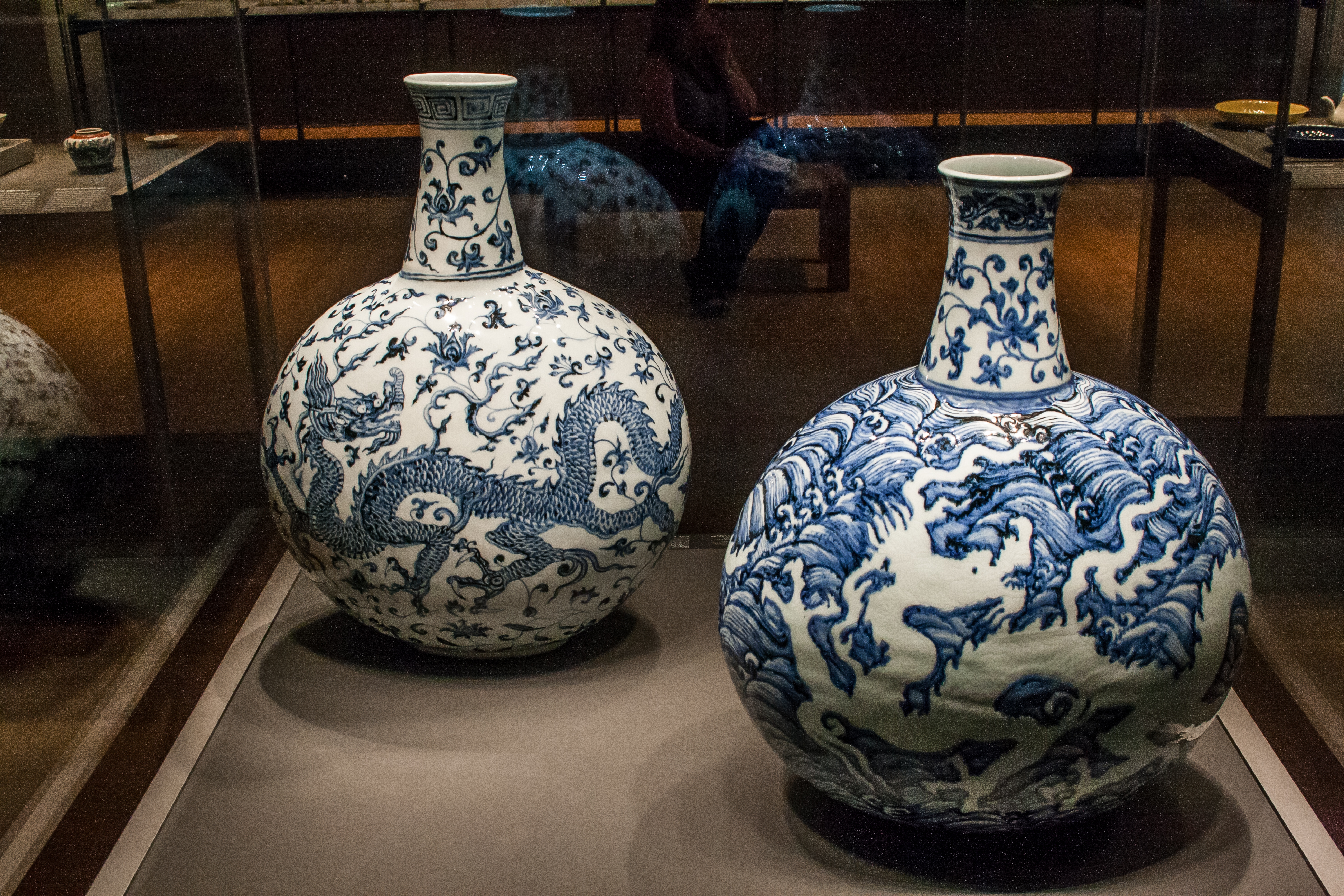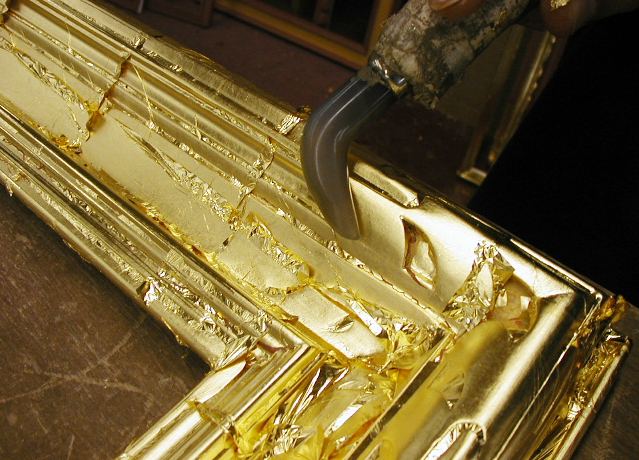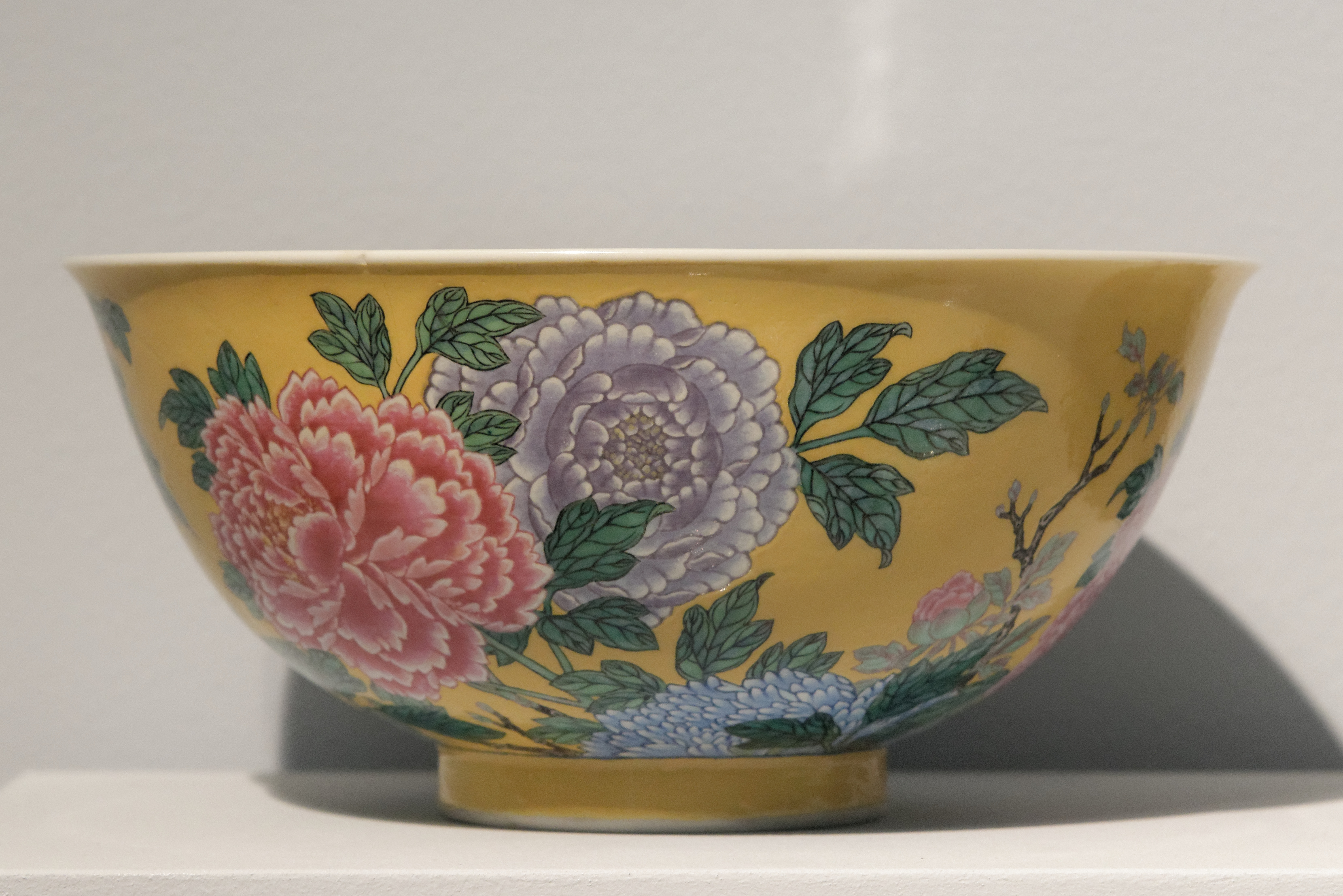|
Sydney Punchbowls
The Sydney punchbowls, made in China during the Jiaqing Emperor's reign (1796–1820) over the mid-Qing dynasty, are the only two known examples of Chinese export porcelain hand painted with Sydney scenes and dating from the Macquarie era. The bowls were procured in Canton about three decades after the First Fleet's arrival at Port Jackson where the British settlement at Sydney Cove was established in 1788. They also represent the trading between Australia and China via India at the time. Even though decorated punchbowls were prestigious items used for drinking punch at social gatherings during the 18th and 19th centuries, it is not known who originally commissioned these bowls or what special occasion they were made for. The punchbowls are a 'harlequin pair', similar but not exactly matching. The bowls have been donated independently, one to the State Library of New South Wales (SLNSW) in 1926 and the other to the Australian National Maritime Museum (ANMM) in 2006. The ... [...More Info...] [...Related Items...] OR: [Wikipedia] [Google] [Baidu] |
Sydney Cove Punchbowl Side And Inside View A281005h
Sydney is the capital city of the States and territories of Australia, state of New South Wales and the List of cities in Australia by population, most populous city in Australia. Located on Australia's east coast, the metropolis surrounds Sydney Harbour and extends about 80 km (50 mi) from the Pacific Ocean in the east to the Blue Mountains (New South Wales), Blue Mountains in the west, and about 80 km (50 mi) from Ku-ring-gai Chase National Park and the Hawkesbury River in the north and north-west, to the Royal National Park and Macarthur, New South Wales, Macarthur in the south and south-west. Greater Sydney consists of 658 suburbs, spread across 33 local government areas. Residents of the city are colloquially known as "Sydneysiders". The estimated population in June 2024 was 5,557,233, which is about 66% of the state's population. Estimated resident population, 30 June 2017. The city's nicknames include the Emerald City and the Harbour City. There is ev ... [...More Info...] [...Related Items...] OR: [Wikipedia] [Google] [Baidu] |
Arthur Phillip
Arthur Phillip (11 October 1738 – 31 August 1814) was a British Royal Navy officer who served as the first Governor of New South Wales, governor of the Colony of New South Wales. Phillip was educated at Royal Hospital School, Greenwich Hospital School from June 1751 until December 1753. He then became an apprentice on the whaling ship ''Fortune''. With the outbreak of the Seven Years' War against France, Phillip enlisted in the Royal Navy as captain's servant to Michael Everitt aboard . With Everitt, Phillip also served on and . Phillip was promoted to lieutenant on 7 June 1761, before being put on half-pay at the end of hostilities on 25 April 1763. Secondment, Seconded to the Portuguese Navy in 1774, he served in the Spanish–Portuguese War (1776–1777), war against Spain. Returning to Royal Navy service in 1778, in 1782 Phillip, in command of , was to capture Spanish colonies in South America, but an armistice was concluded before he reached his destination. I ... [...More Info...] [...Related Items...] OR: [Wikipedia] [Google] [Baidu] |
Chinese Art
Chinese art is visual art that originated in or is practiced in China, Greater China or by Chinese artists. Art created by Chinese residing outside of China can also be considered a part of Chinese art when it is based on or draws on Chinese culture, heritage, and history. Early "Stone Age art" dates back to 10,000 BC, mostly consisting of simple pottery and sculptures. After that period, Chinese art, like Chinese history, was typically classified by the succession of ruling dynasties of Chinese emperors, most of which lasted several hundred years. The Palace Museum in Beijing and the National Palace Museum in Taipei contains extensive collections of Chinese art. Chinese art is marked by an unusual degree of continuity within, and consciousness of, tradition, lacking an equivalent to the Western collapse and gradual recovery of Western classical styles of art. Decorative arts are extremely important in Chinese art, and much of the finest work was produced in large wor ... [...More Info...] [...Related Items...] OR: [Wikipedia] [Google] [Baidu] |
East Indiaman
East Indiamen were merchant ships that operated under charter or licence for European trading companies which traded with the East Indies between the 17th and 19th centuries. The term was commonly used to refer to vessels belonging to the British, Dutch, French, Danish, Swedish, Austrian or Portuguese East India companies. Several East Indiamen chartered by the British East India Company (EIC) were known as clippers. The EIC held a monopoly granted to it by Elizabeth I in 1600 for all English trade between the Cape of Good Hope and Cape Horn. This grant was progressively restricted during the late 18th and early 19th centuries, until the monopoly was lost in 1834. EIC East Indiamen usually ran between Britain, the Cape of Good Hope and India, where their primary destinations were the ports of Bombay, Madras and Calcutta. EIC East Indiamen often continued on to China before returning to England via the Cape of Good Hope and Saint Helena. When the EIC lost its monopoly ... [...More Info...] [...Related Items...] OR: [Wikipedia] [Google] [Baidu] |
Western World
The Western world, also known as the West, primarily refers to various nations and state (polity), states in Western Europe, Northern America, and Australasia; with some debate as to whether those in Eastern Europe and Latin America also constitute the West. The Western world likewise is called the Occident () in contrast to the Eastern world known as the Orient (). Definitions of the "Western world" vary according to context and perspectives; the West is an evolving concept made up of cultural, political, and economic synergy among diverse groups of people, and not a rigid region with fixed borders and members. Some historians contend that a linear development of the West can be traced from Greco-Roman world, Ancient Greece and Rome, while others argue that such a projection constructs a false genealogy. A geographical concept of the West started to take shape in the 4th century CE when Constantine the Great, Constantine, the first Christian Roman emperor, divided the Roman Em ... [...More Info...] [...Related Items...] OR: [Wikipedia] [Google] [Baidu] |
Tableware
Tableware items are the dishware and utensils used for setting a table, serving food, and dining. The term includes cutlery, glassware, serving dishes, serving utensils, and other items used for practical as well as decorative purposes. The quality, nature, variety and number of objects varies according to culture, religion, number of diners, cuisine and occasion. For example, Middle Eastern, Indian or Polynesian food culture and cuisine sometimes limits tableware to serving dishes, using bread or leaves as individual plates, and not infrequently without use of cutlery. Special occasions are usually reflected in higher quality tableware. Cutlery is more usually known as ''silverware'' or ''flatware'' in the United States, where ''cutlery'' usually means knives and related cutting instruments; elsewhere cutlery includes all the forks, spoons and other silverware items. Outside the US, ''flatware'' is a term for "open-shaped" dishware items such as plates, dishes and bo ... [...More Info...] [...Related Items...] OR: [Wikipedia] [Google] [Baidu] |
Chinese Ceramics
Chinese ceramics are one of the most significant forms of Chinese art and ceramics globally. They range from construction materials such as bricks and tiles, to hand-built pottery vessels fired in bonfires or kilns, to the sophisticated Chinese porcelain wares made for the imperial court and for export. The oldest known pottery in the world was made during the List of Paleolithic sites in China, Paleolithic at Xianrendong Cave, Jiangxi Province, China. Chinese ceramics show a continuous development since Chinese Neolithic, pre-dynastic times. Porcelain was a Chinese invention and is so identified with China that it is still called "china" in everyday English usage. Most later Chinese ceramics, even of the finest quality, were made on an industrial scale, thus few names of individual potters were recorded. Many of the most important kiln workshops were owned by or reserved for the emperor, and large quantities of Chinese export porcelain were exported as diplomatic gifts or for ... [...More Info...] [...Related Items...] OR: [Wikipedia] [Google] [Baidu] |
Sample Plate Four Patterns
Sample or samples may refer to: * Sample (graphics), an intersection of a color channel and a pixel * Sample (material), a specimen or small quantity of something * Sample (signal), a digital discrete sample of a continuous analog signal * Sample (statistics), a subset of a population – complete data set People * Sample (surname) * Samples (surname) Places * Sample, Kentucky, unincorporated community, United States * Sampleville, Ohio, unincorporated community, United States * Hugh W. and Sarah Sample House, listed on the National Register of Historic Places in Iowa, United States Music * Sample (music), to reuse a portion of a sound recording in another recording, or the portion reused * "Sample" (Sakanaction song) * "Sample", a song by No-Man from ''Flowermix'' * The Samples, a band from Boulder, Colorado Other uses * USS ''Sample'' (FF-1048), a frigate in the U.S. Navy * The Sample, a defunct department store in Buffalo, New York, U.S. * SAMPLE history, a ... [...More Info...] [...Related Items...] OR: [Wikipedia] [Google] [Baidu] |
Indigenous Australians
Indigenous Australians are people with familial heritage from, or recognised membership of, the various ethnic groups living within the territory of contemporary Australia prior to History of Australia (1788–1850), British colonisation. They consist of two distinct groups, which include many ethnic groups: the Aboriginal Australians of the mainland and many islands, including Aboriginal Tasmanians, Tasmania, and the Torres Strait Islanders of the seas between Queensland and Papua New Guinea, located in Melanesia. 812,728 people Aboriginality, self-identified as being of Aboriginal and/or Torres Strait Islander origin in the 2021 Australian Census, representing 3.2% of the total population of Australia. Of these Indigenous Australians, 91.4% identified as Aboriginal, 4.2% identified as Torres Strait Islander, and 4.4% identified with both groups. The term Aboriginal and Torres Strait Islander peoples or the person's specific cultural group, is often preferred, though the term ... [...More Info...] [...Related Items...] OR: [Wikipedia] [Google] [Baidu] |
Tondo (art)
A ''tondo'' (: ''tondi'' or ''tondos'') is a Renaissance term for a circular work of art, either a painting or a sculpture. The word derives from the Italian ''rotondo'', "round". The term is usually not used in English for small round paintings, but only those over about 60 cm (two feet) in diameter, thus excluding many round portrait miniatures – for sculpture the threshold is rather lower. A circular or oval relief sculpture is also called a roundel. The infrequently-encountered synonym rondoArtlex.com . usually refers to the musical form. History Artists have created ''tondi'' since antiquity. T ...[...More Info...] [...Related Items...] OR: [Wikipedia] [Google] [Baidu] |
Gilding
Gilding is a decorative technique for applying a very thin coating of gold over solid surfaces such as metal (most common), wood, porcelain, or stone. A gilded object is also described as "gilt". Where metal is gilded, the metal below was traditionally silver in the West, to make silver-gilt (or ''vermeil'') objects, but gilt-bronze is commonly used in China, and also called ormolu if it is Western. Methods of gilding include hand application and gluing, typically of gold leaf, chemical gilding, and electroplating, the last also called gold plating. Parcel-gilt (partial gilt) objects are only gilded over part of their surfaces. This may mean that all of the inside, and none of the outside, of a chalice or similar vessel is gilded, or that patterns or images are made up by using a combination of gilt and ungilted areas. Gilding gives an object a gold appearance at a fraction of the cost of creating a solid gold object. In addition, a solid gold piece would often be too soft or to ... [...More Info...] [...Related Items...] OR: [Wikipedia] [Google] [Baidu] |
Famille Rose
Famille rose (French for "pink family") is a style of decoration in Chinese porcelain introduced in the 18th century and defined by pink overglaze enamel as the dominant colour. It is a Western classification for Qing dynasty porcelain known in Chinese by various terms: ''fencai'', ''ruancai'', ''yangcai'', and ''falangcai''. The colour palette is thought to have been brought to China during the reign of Kangxi (1654–1722) by Western Jesuits who worked at the palace, but perfected only in the Yongzheng era when the finest pieces were made, and ''famille rose'' ware reached the peak of its technical excellence during the Qianlong period. Although ''famille rose'' is named after its pink-coloured enamel, the colour may actually range from pale pink to deep ruby. Apart from pink, a range of other soft colour palettes are also used in ''famille rose''. The gradation of colours was produced by mixing coloured enamels with 'glassy white' (玻璃白, ''boli bai''), an opaque whit ... [...More Info...] [...Related Items...] OR: [Wikipedia] [Google] [Baidu] |








